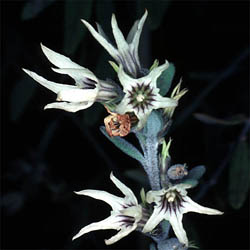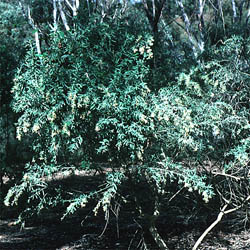Cyphanthera albicans subsp. notabilis
 |
 |
Grey Ray Flower
Cyphanthera albicans (A.Cunn.) Miers
Cyphanthera albicans subsp. notabilis Haegi
The genus Cyphanthera contains nine species and is endemic to southern temperate Australia. It is a member of the Solanaceae family, which also includes the tomato and potato.
 Cyphanthera
albicans subspecies notabilis, formerly known as Anthocercis albicans,
is found only in the Warrumbungle Ranges on the north-western slopes of New
South Wales, where it grows on rocky slopes in dark sandy soils derived from
igneous rocks. Though usually found growing in shrubland on exposed sites, it
also occurs occasionally in dry sclerophyll forest.
Cyphanthera
albicans subspecies notabilis, formerly known as Anthocercis albicans,
is found only in the Warrumbungle Ranges on the north-western slopes of New
South Wales, where it grows on rocky slopes in dark sandy soils derived from
igneous rocks. Though usually found growing in shrubland on exposed sites, it
also occurs occasionally in dry sclerophyll forest.
This subspecies is a beautiful pendulous shrub, 2 m high by 2 m wide, with a whitish downy covering of hairs on the leaves and young branches. The leaves are almost without stalks, ovate or elliptic to oblong in shape, 18-25 mm long and 3-6 mm wide. Compared to the other subspecies (namely subsp. albicans and subsp. tomentosa) this one is particularly floriferous. The flowers, produced in, spring and early summer, are pale yellow to creamy white with purple streak within the short tubular base or corolla. The individual flowers, which are starlike in appearance, can vary from 13 to 22 mm in length, with the narrow petals spreading to 20 mm wide. They are borne in the axils of the upper leaves in clusters of two or three. The fruit is a small, smooth, egg-shaped or globular capsule, opening from the apex by four valves.
Propagation is by cuttings taken in mid-summer and placed in a well-drained cutting mix under moderate humidity. With the use of a softwood rooting hormone, a strike rate above 50 per cent can be expected.
In cultivation this species prefers well-drained soils and dappled shade, though it will tolerate a wide range of conditions including heavy soils, full sunlight and extended dry periods. While not particularly sensitive to frosts, a protected position is recommended in Canberra and on the Southern Tablelands. With age, it tends to become straggly, but this can be prevented by light tip pruning after flowering to encourage a bushier, more compact shape.
While it is relatively free from most common pests and diseases, Botrytis (grey mould) can be a problem in very shaded positions. This fungus can be controlled by spraying though the fungicide concentrate must be handled with care. Consult local experts for advice.
Text by Stephen Hughes, ANBG (1986)
Name meaning: Cyphanthera albicans subsp. notabilis:Cyphanthera - from the Greek, kyphos, bent or bowed forwards, and antheros, anther, referring to the horseshoe-shaped anthers; albicans - from the Latin, albus, white and the suffix -icans, becoming or almost, probably referring to the flower colour; notabilis - from the Latin, remarkable. |
![An Australian Government Initiative [logo]](/images/austgovt_brown_90px.gif)

